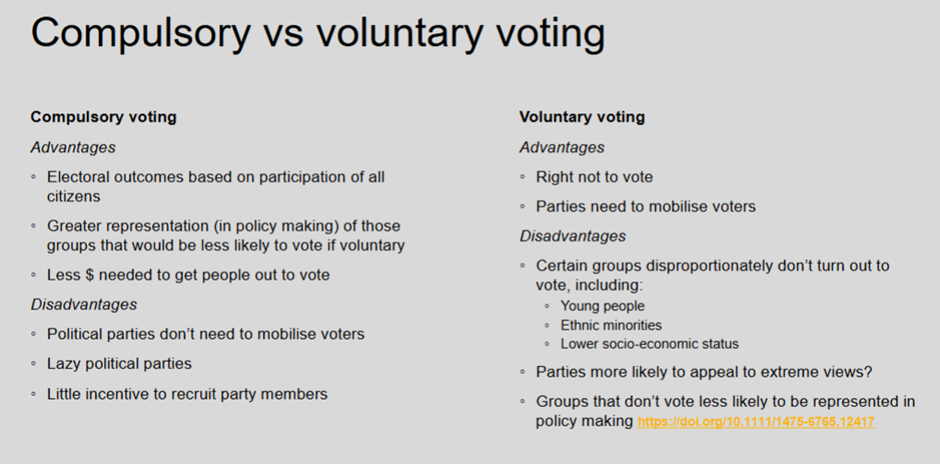Week Six: The Executive and Legislature
1/42
There's no tags or description
Looks like no tags are added yet.
Name | Mastery | Learn | Test | Matching | Spaced |
|---|
No study sessions yet.
43 Terms
What does a constitution need to do?
Set out the rights of citizens
Determine how the country will be run: authoritarian? who makes the law and how (legislature) and who will enforce the law and how? (the executive)
What is the separation of the power?
Limiting the tyranny of the majority (i) – The Separation of Power
◦ Liberal democracies divide power between:
◦ The legislative branch (which makes the law)
◦ The executive branch (which executes the law)
◦ The judicial branch (which adjudicates and applies the law)
◦ No one party of person should control all three branches of government
What is the principle of federalism?
Power is divided between federal, state and sometimes local governments
Ultimate point of separation of the powers?
◦ “The accumulation of all powers, legislative, executive, and judiciary, in
the same hands, whether of one, a few, or many, and whether hereditary, self-
appointed, or elective, may justly be pronounced the very definition of
tyranny.” James Maddison, The Federalist Papers No. 47
- Ultimately it doesn’t matter how they get the power but rather that it is not consolidated in the hands of one individual
Recent concerns on the separation of powers?
Lately, there have been concerns on the erosion of separation of powers. Examples include the Hunter Biden incident. This includes the President breaching into the judiciary (Biden) and saying his son could not be charged with any crimes. The principle of the separation of power appears to be eroding in the USA.
What is the constitutional structure?
◦ Presidential or parliamentary executive
◦ Bicameral or unicameral legislature
◦ Unitary government or federal government
What are the various types of electoral systems?
◦ Majoritarian / Proportional Representation / Combined
◦ Compulsory vs voluntary voting
◦ Preferential voting
◦ Parliamentary terms (e.g. 3,4,5 years)
How can the frameworks of institutions affect government?
◦ Strong government that can get things done vs. checks and balances
◦ Clear/blurred lines of accountability
◦ Voters or parties have control over head of government
◦ Competition vs. collaboration between parties
◦ Proportionality of votes to seats (fair outcomes)
◦ The make-up of parliaments (representation of women and minorities, balance of parties, concentration
◦ The make-up of parliaments (representation of women and minorities, balance of parties, concentration
of major parties, or representation of minor parties)
◦ Regular opportunities to get rid of governments (short electoral terms) vs. time for governments to actually govern (longer electoral terms
What is the executive government as ‘leadership’?
◦ Head of state and head of government
◦ Sets policy and political direction
What is executive government as ‘executor’?
◦ Mobilises support
◦ Resolving crises, making decisions
◦ Oversees implementation
What is the head of state vs head of government?
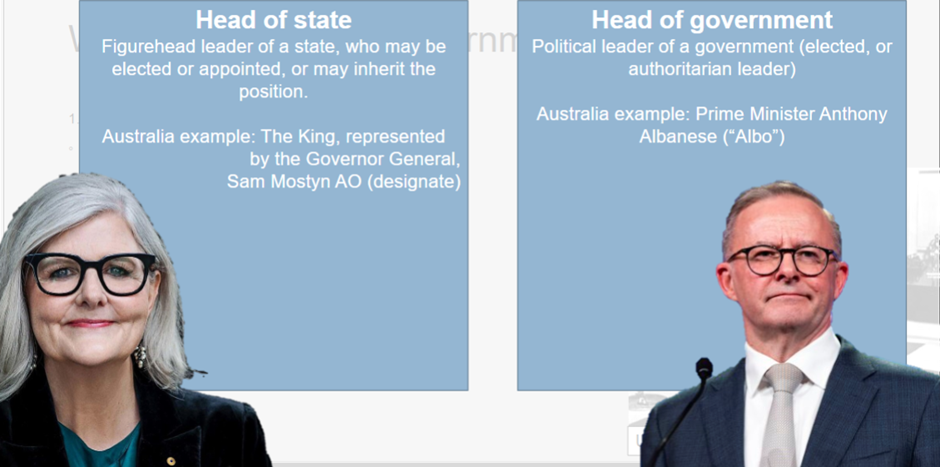
Some governments do not have distinction, for example the United States. The figurehead of the state and the political leader are inseparable.
What are the two main types of democracy?
Parliamentary and Presidential
What are some similarities between parliamentary sand presidential government?
◦ Personalisation
◦ “Chief diplomat” and principle politician
◦ Apex of bureaucraciesWha
What are some differences between parliamentary and presidential government?
Power over legislation
Origin: Source of executive authority
Survival: Accountability mechanisms
Characteristics of Parliamentary Democracy
Is not elected directly by the people
Within parliament, the executive (ie Albanese) are within the legislature and sit within the parliament
Accountability comes from the party, can be removed when confidence is lost
Venn Diagram of Parliamentary and Presidential Government:
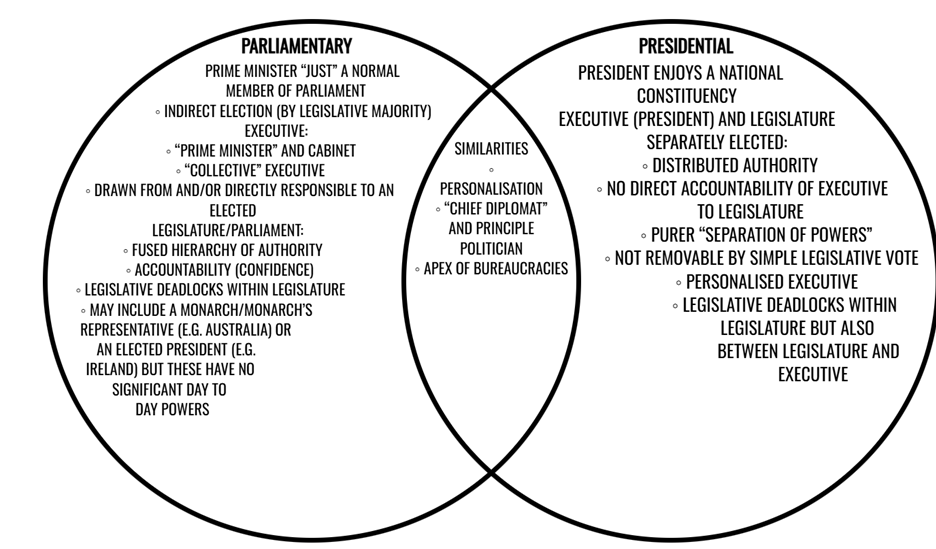
Characteristics of Presidential Democracy:
1. Directly elected by the people, do not sit within congress (do not sit in there)
2. No direct accountability to legislature – a lot more complicated to remove a president (ie, Impeachment, but it’s a very difficult process and does not occur often)
3. The president directly picks who they want to be executive and do not have to pick people from within the parliament
Key features of Semi-Presidentialism?
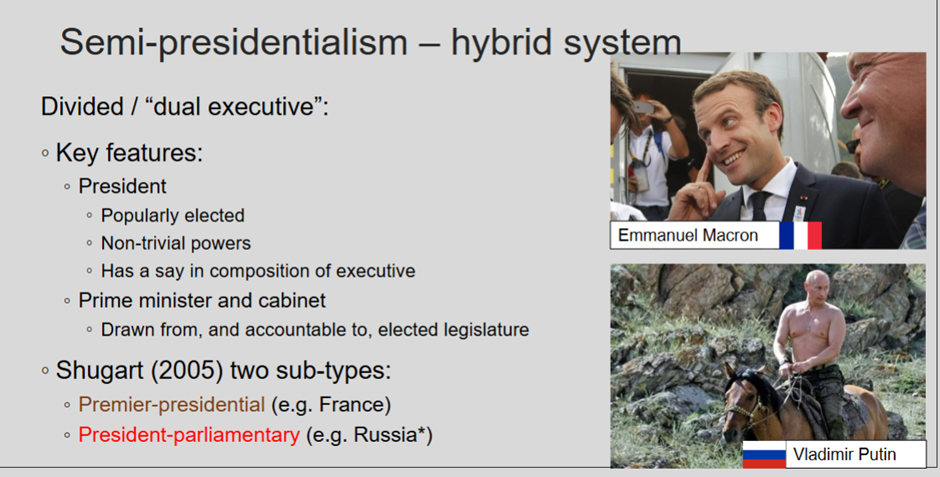
Semi-presidentialism – makes it hard to work together. IE France: Macron is centrist, the far left is the majority, and hence a centrist leader will not be let in because the far left has the voting power.
The ‘people’ and the executive

Premier Presidential vs President Parliamentary
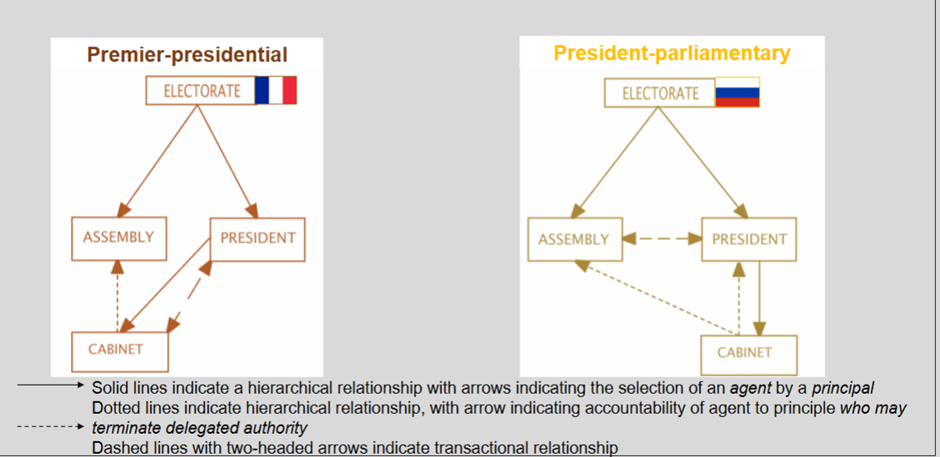
How does distribution of power reflect historical imperialism and contagion?
Parliamentary:
◦ Predominantly found in western Europe, Scandinavia and Commonwealth countries (former
British Empire colonies)
Presidential:
◦ Predominantly found in Americas
◦ Semi-presidential:
◦ Predominantly found in former Soviet-dominated countries, former French and Portuguese African
colonies
But!
◦ There are exceptions and regimes that do not fit neatly into these categories.
Hence the process of colonisation significantly influenced who would end up - - parliamentary or presidential
The perils of presidentialism according to Linz?
◦ Elections are a zero-sum game: one winner
◦ Weaker partisan links with legislature, fewer coalition incentives, less cooperation, more potential gridlock
◦ Rival sources of legitimacy: legislature and executive
◦ Difficulties of removing unpopular or corrupt leaders and lack of smooth executive succession (eg Boris Johnson removed)
◦ Depends upon the qualities of an individual leader – high risk
◦ More breakdown of democratic states in presidential regimes (especially in Latin America)
◦ “While parliamentarism imparts flexibility to the political process, presidentialism makes it rather rigid.” (Linz 1990)
◦ Tensions between desire for strong leader and need for constraints.
Parliaments are flexible, whereas Presidentialism is constraints.
Debate on whether Prime Ministers and Presidents are Interchangable?
Debate on whether Prime Ministers and Presidents are interchangeable?
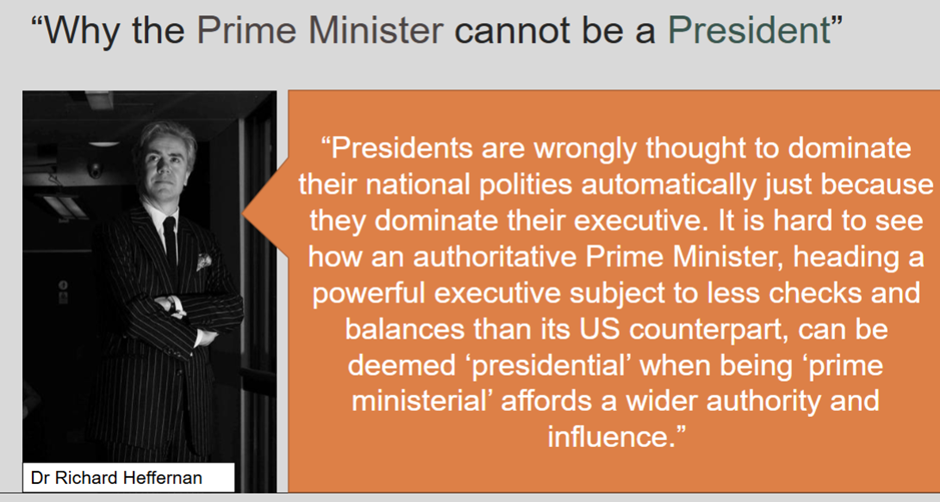
- Prime ministers have more power
- Presidents sit outside and negotiate with their party members in an attempt to convince them to vote a certain way.
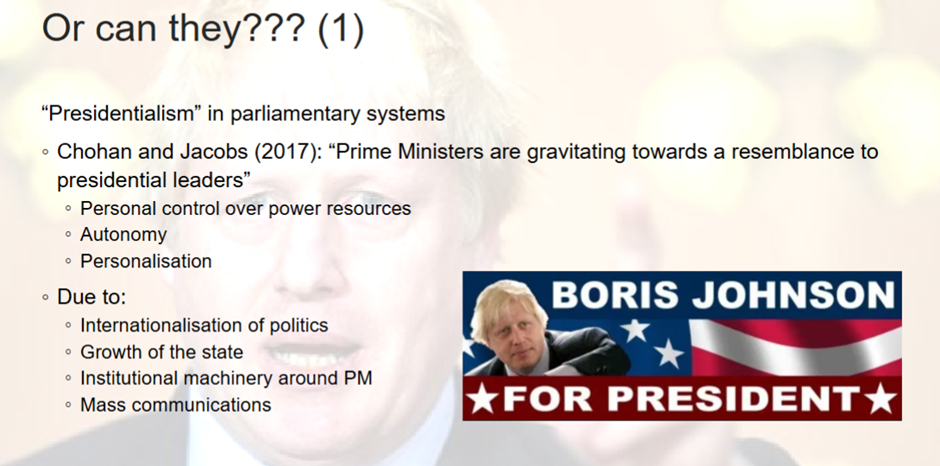
At the national level and foreign policy level, there are not many checks and balances on the President. Their power is constrained in the domestic not so much international.
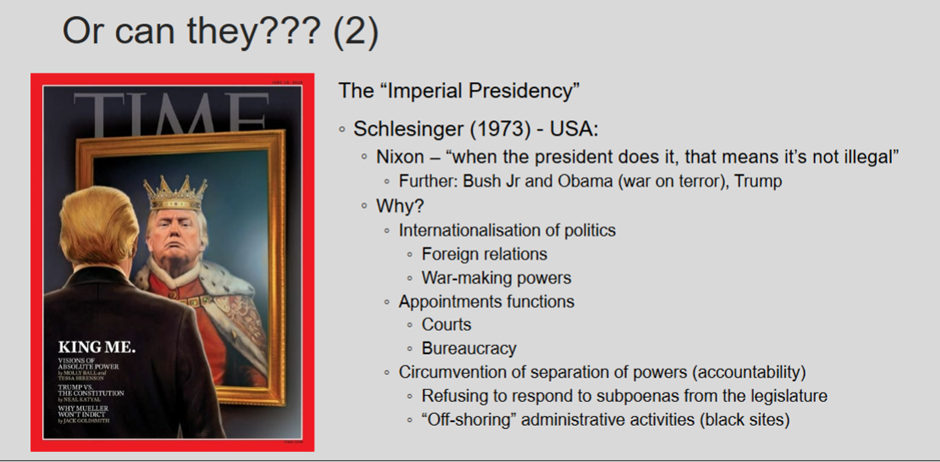
What is a unitary state?
central government in charge of running the entire country
What is a federation??
A federal government but also state government with significant power and influence. Federal countries tend to be larger, smaller unitary.
Arguments for and against decentralised government?
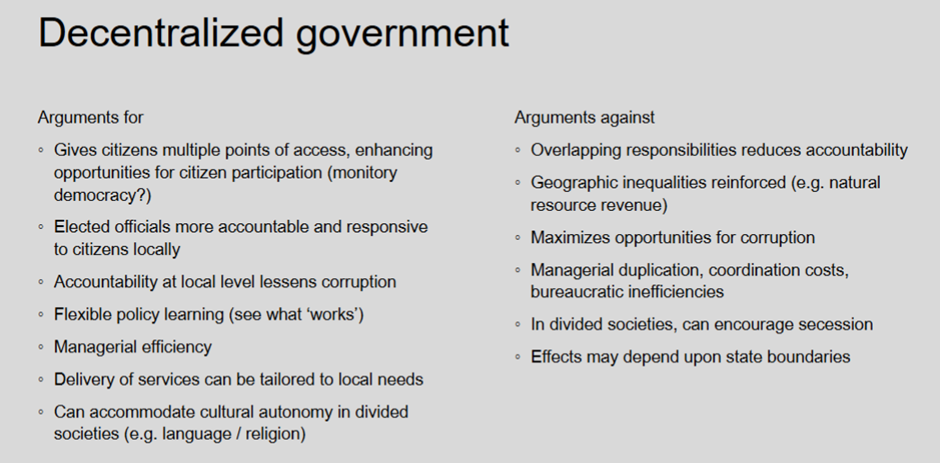
What is a legislature?
Mutli-member representative body which considers public issues and either accepts, amends or rejects proposals for new laws and policies
Definition of Legislature?
◦ An ‘institution’.
◦ One of the ‘branches’ of government (or ‘the state’):
◦ Executive, legislature, and judiciary.
◦ The one that ‘makes the law’, or at least ‘approve[s] measures that will form the law’ (Norton 2013).
What are the functions of legislature?
◦ Making laws
◦ Place of deliberation
◦ Source of governments
◦ Role of legislatures in democratic development (Rokkan, 1970)
◦ Emphasis on “opposition rights”
◦ Source of accountability
◦ Representation
What makes a legislature a ‘parliament’?
◦ The executive (prime minister and cabinet) is drawn from and/or directly responsible to an elected parliament:
◦ Right to select and dismiss the government (“confidence”)
◦ ‘Fused’ executive
◦ Direct accountability (confidence)
◦ Legislative deadlocks within legislature
◦ May include a monarch/monarch’s representative (e.g., Australia) or an elected president (e.g., Ireland) but these have no significant day-to-day powers.
What makes a legislature a ‘congress’?
◦ The executive (president) and congress are
separately elected:
◦ Distributed authority
◦ No direct accountability of executive to legislature (purer ‘separation of powers’)
◦ Legislative deadlocks within legislature but also between legislature and executive.
◦ Does not “select” government, limited rights to dismiss (impeachment in US)
Differences between parliament or presidential system?
◦ Sources and patterns of authority
◦ Executive accountability mechanisms
◦ “Veto points” for legislation
◦ Linz (1990)
◦ Resilience and persistence of democratic regimes are greater
in parliamentary systems
What does majoritan vs proportional representation look like?
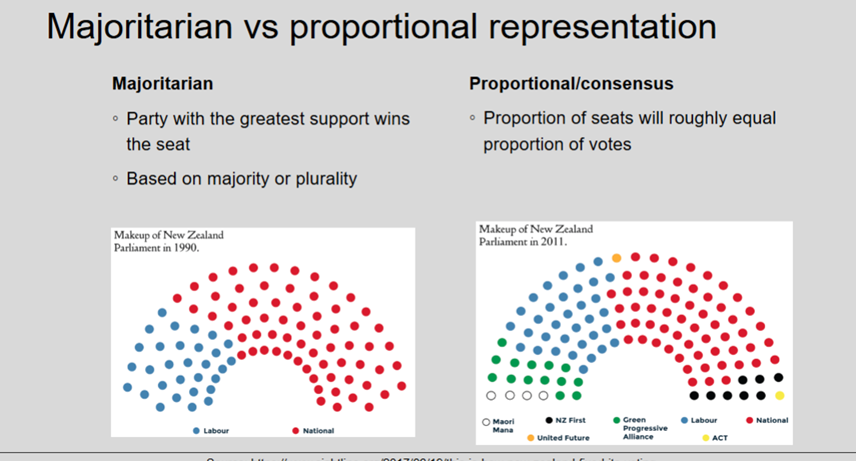
How is majoritanism typically categorised?
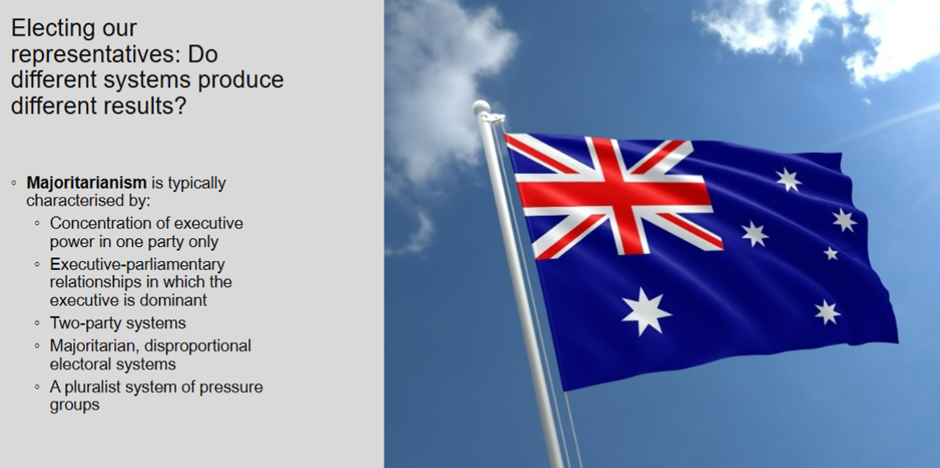
How is consensus system(s) typically categorised?
ositive a
What are the positive and negative impacts of electoral systems?
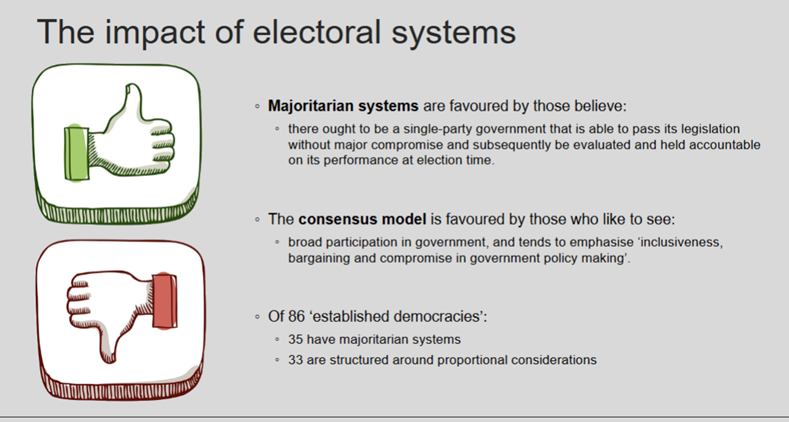
What is the ‘first past the post’ electoral system?
Voters simply mark their single preferred candidate
◦ Whoever gets the most votes is elected regardless of whether they obtain an overall majority of votes
◦ The more candidates standing in an election, the fewer votes an individual candidate may need to get the highest number of votes
◦ Has been used in the UK for centuries and many of its former colonies: USA, Canada, India
◦ Criticised as undemocratic as a government can be formed without a majority of the vote (37-38% regularly in the UK)
◦ “Wasted votes”
- More options to vote mean less votes required to win.
What is the preferential system (instant runoff voting) used in the lower house?
◦ At the core of this system is the idea that the winner needs to obtain the majority of votes
◦ The distribution of preferences comes into play when there are more than two candidates and no candidate has won an outright majority
◦ The candidate with the lowest primary vote is eliminated and his/her preferences are allocated.
This continues until a candidate gains a majority of votes.
◦ Usually, however, the candidate with the plurality of votes goes on to gain the majority.
◦ Can support minor party or Independent candidates then use second preference to
determine outcome
What is proportional Representation?
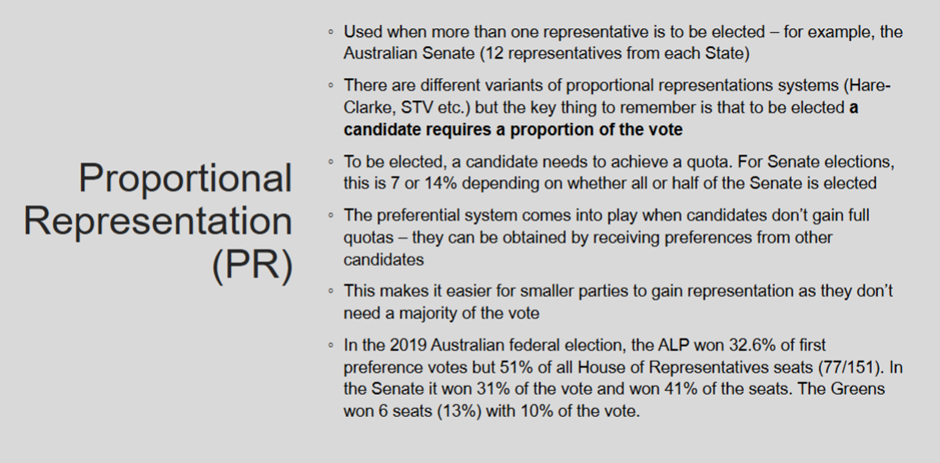
What is unicameral legislature?
◦ Earliest (non-democratic) parliaments unicameral.
◦ Around 40% of current national legislatures.
◦ Now usually some based on some democratic representative principle: local communities (Papua New Guinea) or proportionality (Denmark).
◦ What if the rationale seems defective (e.g., because of executive dominance)?
◦ Combine two or more representative rationales within a single chamber
(e.g., Aotearoa New Zealand post-1994)
What is bicameral parliament?
◦ Two houses/chambers.
◦ Majority of legislatures (60%)
◦ No point if they are identical in composition.
According to Russel, what is the strength(s) of bicameralism?
◦ Congruence (of composition) -> slightly different pattern of people -> more power
◦ Symmetry (of powers).
◦ Legitimacy (of second house).
◦ Australian houses:
◦ Incongruent; symmetrical; legitimate.
◦ Strong bicameralism (e.g., Australia) leads to the problem of deadlocks.
◦ Weak bicameralism leads to the problem of relevance (and possible abolition, e.g. NZ 1950)
What is compulsory vs voluntary voting?
